Environmental Management and Landscape Transformation on Self-Heating Coal-Waste Dumps in the Upper Silesian Coal Basin
Abstract
1. Introduction
2. Materials and Methods
2.1. Study Area
2.2. Cartographic Investigation
2.3. Thermal Investigation
2.4. Vegetation Investigation
2.5. Vegetation Mapping
3. Results
3.1. Topography and Structure
3.2. Thermal Conditions
3.3. Flora Diversity
3.4. Vegetation Community in D-RS-1
3.5. Vegetation Community in D-B-2
3.6. Socioecological Diversity of Flora
3.7. The Raunkiær Plant Life-Forms
4. Discussion
5. Conclusions
Supplementary Materials
Author Contributions
Funding
Institutional Review Board Statement
Informed Consent Statement
Data Availability Statement
Conflicts of Interest
References
- Hilson, G. Pollution prevention and cleaner production in the mining industry: An analysis of current issues. J. Clean. Prod. 2000, 8, 119–126. [Google Scholar] [CrossRef]
- Xu, J.; Zhao, H.; Yin, P.; Wu, L.; Li, G. Landscape ecological quality assessment and its dynamic change in coal mining area: A case study of Peixian. Environ. Earth Sci. 2019, 78, 708. [Google Scholar] [CrossRef]
- Dulias, R. Landscape planning in areas of sand extraction in the Silesian Upland, Poland. Landsc. Urban Plan. 2010, 95, 91–104. [Google Scholar] [CrossRef]
- Gorova, A.; Pavlychenko, A.; Kulyna, S. Ecological Problem of post-mining areas. In Geomechanical Processes During Underground Mining; Pivnyak, G., Bondarenko, V., Kovalevs’ka, I., Illiashov, M., Eds.; CRC Press: Boca Raton, FL, USA, 2012; ISBN 978-0-415-66174-4. [Google Scholar]
- Lei, K.; Pan, H.; Lin, C. A landscape approach towards ecological restoration and sustainable development of mining areas. Ecol. Eng. 2016, 90, 320–325. [Google Scholar] [CrossRef]
- Mi, J.; Yang, Y.; Zhang, S.; An, S.; Hou, H.; Hua, Y.; Chen, F. Tracking the Land Use/Land Cover Change in an Area with Underground Mining and Reforestation via Continuous Landsat Classification. Remote Sens. 2019, 11, 1719. [Google Scholar] [CrossRef]
- Banks, G. Mining and the environment in Melanesia: Contemporary debates reviewed. Contemp. Pac. 2002, 14, 39–67. [Google Scholar] [CrossRef]
- Mensah, S.O.; Okyere, S.A. Mining, Environment and Community Conflicts: A Study of Company-Community Conflicts over Gold Mining in the Obuasi Municipality of Ghana. J. Sustain. Dev. Stud. 2014, 5, 64–99. [Google Scholar]
- Milbourne, P.; Mason, K. Environmental injustice and post-colonial environmentalism: Opencast coal mining, landscape and place. Environ. Plan. A Econ. Space 2016, 49, 29–46. [Google Scholar] [CrossRef]
- Si, H.; Bi, H.; Li, X.; Yang, C. Environmental evaluation for sustainable development of coal mining in Qijiang, Western China. Int. J. Coal Geol. 2010, 81, 163–168. [Google Scholar] [CrossRef]
- Demirel, N.; Düzgün, Ş.; Emil, M.K. Landuse change detection in a surface coal mine area using multi-temporal high-resolution satellite images. Int. J. Min. Reclam. Environ. 2011, 25, 342–349. [Google Scholar] [CrossRef]
- Laurence, D. Establishing a sustainable mining operation: An overview. J. Clean. Prod. 2010, 19, 278–284. [Google Scholar] [CrossRef]
- Hendrychová, M. Reclamation success in post-mining landscapes in the Czech Republic: A review of pedological and biological studies. J. Landsc. Stud. 2008, 1, 63–78. [Google Scholar]
- Hu, Z.Q.; Xiao, W.; Wang, P.J.; Zhao, Y.L. Concurrent mining and reclamation for underground coal mining. J. China Coal Soc. 2013, 38, 301–307. [Google Scholar]
- Hendrychová, M.; Kabrna, M. An analysis of 200-year-long changes in a landscape affected by large-scale surface coal mining: History, present and future. Appl. Geogr. 2016, 74, 151–159. [Google Scholar] [CrossRef]
- Huang, Y.; Zhang, J.; Zhang, Q.; Nie, S. Backfilling technology of substituting waste and fly ash for coal underground in China coal mining area. Environ. Eng. Manag. J. 2011, 10, 769–775. [Google Scholar] [CrossRef]
- Pactwa, K.; Woźniak, J.; Dudek, M. Coal mining waste in Poland in reference to circular economy principles. Fuel 2020, 270. [Google Scholar] [CrossRef]
- Sokół, W.; Tabor, A. Problemy zagospodarowania odpadów powęglowych z górnictwa węgla kamiennego w Polsce. Przegląd Geologiczny 1996, 44, 710–715. [Google Scholar]
- National Research Council; Division on Earth and Life Studies; Board on Earth Sciences and Resources; Committee on Earth Resources; Committee on Coal Waste Impoundments. Coal Waste Impoundments: Risks, Responses, and Alternatives; National Academies Press: Washington, DC, USA, 2002; ISBN 030908251X. [Google Scholar]
- Borowski, G.; Hycnar, J.J. Utilization of Fine Coal Waste as a Fuel Briquettes. Int. J. Coal Prep. Util. 2013, 33, 194–204. [Google Scholar] [CrossRef]
- Wójcik, J. Zróżnicowanie kształtu i cech morfometrycznych zwałów jako podstawa do oceny przeobrażenia rzeźby terenu przez górnictwo węglowe. Badania Fizjograficzne 2006, 57, 149–159. [Google Scholar]
- Zástěrová, P.; Marschalko, M.; Niemiec, D.; Durďák, J.; Bulko, R.; Vlček, J. Analysis of Possibilities of Reclamation Waste Dumps after Coal Mining. Procedia Earth Planet. Sci. 2015, 15, 656–662. [Google Scholar] [CrossRef]
- Adibee, N.; Osanloo, M.; Rahmanpour, M. Adverse effects of coal mine waste dumps on the environment and their management. Environ. Earth Sci. 2013, 70, 1581–1592. [Google Scholar] [CrossRef]
- Prakash, A.; Fielding, E.J.; Gens, R.; Van Genderen, J.L.; Evans, D.L. Data fusion for investigating land subsidence and coal fire hazards in a coal mining area. Int. J. Remote Sens. 2001, 22, 921–932. [Google Scholar] [CrossRef]
- Jelínek, P.; Marschalko, M.; Lamich, D.; Yilmaz, I.; Zastěrová, P.; Bednárik, M.; Heviánková, S.; Kyncl, M.; Drusa, M.; Růčková, H. Monitoring and analysis of burning in coal tailing dumps: A case study from the Czech Republic. Environ. Earth Sci. 2015, 73, 6601–6612. [Google Scholar] [CrossRef]
- Nádudvari, Á.; Abramowicz, A.; Fabiańska, M.J.; Misz-Kennan, M.; Ciesielczuk, J. Classification of fires in coal waste dumps based on Landsat, Aster thermal bands and thermal camera in Polish and Ukrainian mining regions. Int. J. Coal Sci. Technol. 2020. [Google Scholar] [CrossRef]
- Civeira, M.S.; Pinheiro, R.N.; Gredilla, A.; de Vallejuelo, S.F.O.; Oliveira, M.L.S.; Ramos, C.G.; Traffarel, S.R.; Kautzmann, R.M.; Madariaga, J.M.; Silva, L.F.O. The properties of the nano-minerals and hazardous elements: Potential environmental impacts of Brazilian coal waste fire. Sci. Total Environ. 2016, 544, 892–900. [Google Scholar] [CrossRef] [PubMed]
- Ribeiro, J.; Flores, D.; Ward, C.R.; Silva, L.F.O. Identification of nanominerals and nanoparticles in burning coal waste piles from Portugal. Sci. Total Environ. 2010, 408, 6032–6041. [Google Scholar] [CrossRef]
- Ribeiro, J.; Suárez-Ruiz, I.; Ward, C.R.; Flores, D. Petrography and mineralogy of self-burning coal wastes from anthracite mining in the El Bierzo Coalfield (NW Spain). Int. J. Coal Geol. 2016, 154–155, 92–106. [Google Scholar] [CrossRef]
- O’Keefe, J.M.K.; Henke, K.R.; Hower, J.C.; Engle, M.A.; Stracher, G.B.; Stucker, J.D.; Drew, J.W.; Staggs, W.D.; Murray, T.M.; Hammond, M.L., III; et al. CO2, CO, and Hg emissions from the Truman Shepherd and Ruth Mullins coal fires, eastern Kentucky, USA. Sci. Total Environ. 2010, 408, 1628–1633. [Google Scholar]
- Kuenzer, C.; Zhang, J.; Tetzlaff, A.; van Dijk, P.; Voigt, S.; Mehl, H.; Wagner, W. Uncontrolled coal fires and their environmental impacts: Investigating two arid mining regions in north-central China. Appl. Geogr. 2007, 27, 42–62. [Google Scholar] [CrossRef]
- Ciesielczuk, J.; Misz-Kennan, M.; Hower, J.C.; Fabiańska, M.J. Mineralogy and geochemistry of coal wastes from the Starzykowiec coal-waste dump (Upper Silesia, Poland). Int. J. Coal Geol. 2014, 127, 42–55. [Google Scholar] [CrossRef]
- Tobin-Janzen, T.; Shade, A.; Marshall, L.; Torres, K.; Beblo, C.; Janzen, C.; Lenig, J.; Martinez, A.; Ressler, D. Nitrogen changes and domain bacteria ribotype diversity in soils overlying the Centralia, Pennsylvania underground coal mine fire. Soil Sci. 2005, 170, 191–201. [Google Scholar] [CrossRef]
- Ciesielczuk, J.; Czylok, A.; Fabiańska, M.J.; Misz-Kennan, M. Plant occurrence on burning coal waste–a case study from the Katowice-Wełnowiec dump, Poland. Environ. Soc. Econ. Stud. 2015, 3, 1–10. [Google Scholar] [CrossRef]
- Pertile, E.; Fečko, P.; Nezvalová, L.; Guziurek, M.; Wolfová, R.; Tora, M. Reclamation using waste rock impact on water quality in the Karvina region in Czech Republic. Inżynieria Mineralna 2010, 11, 33–39. [Google Scholar]
- Pertile, E.; Surovka, D.; Sarčáková, E.; Božoň, A. Monitoring of Pollutants in an Active Mining Dump Ema, Czech Republic. Inżynieria Mineralna 2017, 18, 45–50. [Google Scholar]
- Tichanek, F.; Tichanek, R. Contribution to the solution of thermally active reclamation of coal waste heaps. In Proceedings of the International Multidisciplinary Scientific GeoConference: SGEM, Albena, Bulgaria, 17–26 June 2014; pp. 777–791. [Google Scholar]
- Marcisz, M.; Probiesz, K.; Gawor, Ł. Possibilities of reclamation and using of large-surface coal mining dumping grounds in Poland. Gospod. Surowcami Miner. Miner. Resour. Manag. 2020, 36, 105–122. [Google Scholar]
- Łączny, J.M.; Baran, J.; Ryszko, A. Opracowanie i Wdrażanie Innowacyjnych Technologii Środowiskowych Stosowanych na Zwałowiskach Odpadów Powęglowych; Wydawnictwo Naukowe Instytutu Technologii Eksploatacji–PIB: Radom, Poland, 2012; p. 300. [Google Scholar]
- Rahmonov, O.; Krzysztofik, R.; Środek, D.; Smolarek-Lach, J. Vegetation- and Environmental Changes on Non-Reclaimed Spoil Heaps in Southern Poland. Biology 2020, 9, 164. [Google Scholar] [CrossRef]
- Rostański, A. Spontaneous Plant Cover on Colliery Spoil Heaps in Upper Silesia (Southern Poland); University of Silesia Publisher: Katowice, Poland, 2006; p. 230. [Google Scholar]
- Woźniak, G. Diversity of Vegetation on Coal-Mine Heaps of the Upper Silesia (Poland); W. Szafer Institute of Botany-Polish Academy of Sciences: Cracow, Poland, 2010. [Google Scholar]
- Prach, K.; Pyšek, P. Using spontaneous succession for restoration of human-disturbed habitats. Experience from Central Europe. Ecol. Eng. 2001, 17, 55–62. [Google Scholar] [CrossRef]
- Baasch, A.; Kirmer, A.; Tischew, S. Nine years of vegetation development in a postmining site: Effects of spontaneous and assisted site recovery. J. Appl. Ecol. 2011, 49. [Google Scholar] [CrossRef]
- Kompała-Bąba, A.; Bierza, W.; Błońska, A.; Sierka, E.; Magurno, F.; Chmura, D.; Bedenyei, L.; Radosz, Ł.; Woźniak, G. Vegetation diversity on coal mine spoil heaps–how important is the texture of the soil substrate? Biologia 2019, 74, 419–436. [Google Scholar] [CrossRef]
- Błońska, A.; Kompała-Bąba, A.; Sierka, E.; Bierza, W.; Magurno, F.; Besenyei, L.; Ryś, K.; Woźniak, G. Diversity of vegetation dominated by selected grass species on coal-mine spoil heaps in terms of reclamation of post-industrial areas. J. Ecol. Eng. 2019, 20, 209–217. [Google Scholar] [CrossRef]
- Rahmonov, O.; Snytko, V.A.; Szczypek, T.; Parusel, T. Vegetation development on post-industrial territories of the Silesian Upland (Southern Poland). Geogr. Nat. Resour. 2013, 34, 96–103. [Google Scholar] [CrossRef]
- Dulias, R. The Impact of Mining on the Landscape—A Study of the Upper Silesian Coal Basin in Poland; Springer: Cham, Switzerland, 2016; p. 209. [Google Scholar]
- Kędzior, S.; Dreger, M. Methane occurrence, emissions and hazards in the Upper Silesian Coal Basin, Poland. Int. J. Coal Geol. 2019, 211, 103226. [Google Scholar] [CrossRef]
- Sułkowski, J.; Drenda, J.; Różański, Z.; Wrona, P. Noticed in mining areas, environmental hazard connected with outflow of gases from abandoned mine sand with spontaneous ignition of coal waste dumps. Gospod. Surowcami Miner. Miner. Resour. Manag. 2008, 24, 319–333. [Google Scholar]
- Gawor, Ł. Coal mining waste dumps as secondary deposits–examples from the Upper Silesian Coal Basin and the Lublin Coal Basin. Geol. Geophys. Environ. 2014, 40, 285–289. [Google Scholar] [CrossRef]
- Bian, Z.; Inyang, H.I.; Daniels, J.L.; Otto, F.; Struthers, S. Environmental issues from coal mining and their solutions. Min. Sci. Technol. (China) 2010, 20, 215–223. [Google Scholar] [CrossRef]
- Roekaerts, M. The Biogeographical Regions Map of Europe. Basic Principles of its Creation and Overview of its Development; European Environment Agency: Luxembourg, 2002. [Google Scholar]
- Matuszkiewicz, J.M. Vegetation Landscape and Geobotanical Regions of Poland; Zakład Narodowy Im; Ossolińskich Wydawnictwo PAN: Wrocław, Poland, 1993; p. 105. [Google Scholar]
- Matuszkiewicz, W.; Faliński, J.B.; Kostrowicki, A.S.; Matuszkiewicz, J.M.; Olaczek, R.; Wojterski, T. Potencjalna Roślinność Naturalna Polski. Mapa Przeglądowa 1:300 000. Arkusze 1–12; IGiPZ PAN: Warsaw, Poland, 1995. [Google Scholar]
- Geoportal of Poland. Available online: https://mapy.geoportal.gov.pl (accessed on 21 December 2020).
- Database of Institute of Meteorology and Water Management–National Research Institute. Available online: https://danepubliczne.imgw.pl (accessed on 21 December 2020).
- Solarski, M. Anthropogenic transformations of the Bytom area relief in the period of 1883-1994. Environ. Soc. Econ. Stud. 2013, 1, 1–8. [Google Scholar] [CrossRef]
- Google Earth. Available online: https://earth.google.com (accessed on 21 December 2020).
- Open-Access Regional Spatial Information System–ORSIP. Available online: https://www.mapy.orsip.pl (accessed on 21 December 2020).
- Nowak, H. The influence of environmental thermal radiation on the results of thermographic investigation of buildings. Bud. Archit. 2013, 12, 59–66. [Google Scholar] [CrossRef]
- Wawrzyniak, V.; Piégay, H.; Allemand, P.; Vaudor, L.; Goma, R.; Grandjean, P. Effects of geomorphology and groundwater level on the spatio-temporal variability of riverine cold water patches assessed using thermal infrared (TIR) remote sensing. Remote Sens. Environ. 2016, 175, 337–348. [Google Scholar] [CrossRef]
- Cárdenas-Del Campo, P.; Soto-Lara, F.; Marín-Granados, M. Description of Moisture Thermal Patterns in Concrete for the Thermal Inspection Method by Infrared Thermography. In Advances on Mechanics, Design Engineering and Manufacturing II. Lecture Notes in Mechanical Engineering; Cavas-Martínez, F., Eynard, B., Fernández Cañavate, F., Fernández-Pacheco, D., Morer, P., Nigrelli, V., Eds.; Springer: Cham, Switzerland, 2019. [Google Scholar]
- Oberdorfer, E.; Muller, T.; Korneck, D.; Lippert, W.; Markgraf-Dannenberg, I.; Patzke, E.; Weber, H.E. Pflanzensoziologische Excursionflora 6; Ulmer: Stuttgart, Germany, 1990. [Google Scholar]
- Matuszkiewicz, J.M. Potential Vegetation of Poland; Polish Academy of Science: Warsaw, Poland, 2008. [Google Scholar]
- Zarzycki, K.; Trzcińska-Tacik, H.; Różański, W.; Szeląg, Z.; Wołek, J.; Korzeniak, U. Ecological Indicator Values of Vascular Plants of Poland; W. Szafer Institute of Botany-Polish Academy of Sciences: Cracow, Poland, 2002. [Google Scholar]
- Mirek, Z.; Piękoś-Mirkowa, H.; Zając, A.; Zając, M. Flowering Plants and Pteridophytes of Poland. A Checklist. Biodiversity of Poland; W. Szafer Institute of Botany-Polish Academy of Sciences: Cracow, Poland, 2002. [Google Scholar]
- Rutkowski, L. Key for Vascular Plants Identification; Polish Scientific Press: Warszawa, Poland, 2011. [Google Scholar]
- Braun-Blanquet, J. Pflansensoziologie; Springer: Vienna, Austria, 1964; p. 631. [Google Scholar]
- Łączny, J.M.; Bondaruk, J.; Janik, A. Problematyka Przywracania Terenów Zwałowisk Odpadów Powęglowych do Obiegu Gospodarczo-Społecznego; Wydawnictwo Naukowe Instytutu Technologii Eksploatacji–PIB: Radom, Poland, 2012; p. 279. [Google Scholar]
- Szczepańska, J.; Twardowska, I. Distribution and environmentalimpact of coal-mining wastes in Upper Silesia, Poland. Cases and solutions. Environ. Geol. 1999, 38, 249–258. [Google Scholar] [CrossRef]
- Hancock, G.R.; Loch, R.J.; Willgoose, G.R. The design of post-mining landscapes using geomorphic principles. Earth Surf. Process. Landf. 2003, 28, 1097–1110. [Google Scholar] [CrossRef]
- Tokarska-Guzik, B. Natural management of post-industrial sites. In Proceedings of the Warsztaty nt. Przywracanie Wartości użytkowych Terenom Górniczym, Wieliczka, Poland, 29 May–1 June 2001; pp. 209–222. [Google Scholar]
- Rogalski, L.; Błaszczok, A.; Bęś, A. Reclamation of degraded postmining terrains as an element of sustainable development. Inżynieria Ekol. 2006, 15, 57–63. [Google Scholar]
- Larondelle, N.; Haase, D. Valuing post-mining landscapes using an ecosystem services approach—An example from Germany. Ecol. Indic. 2012, 18, 567–574. [Google Scholar] [CrossRef]
- Zástěrová, P.; Marschalko, M.; Durďák, J.; Niemiec, D. Nature Conditions of Waste Dumps in the Czech Part of the Upper Silesian Coal Basin. Procedia Earth Planet. Sci. 2015, 15, 395–400. [Google Scholar] [CrossRef]
- Soltanmohammadi, H.; Osanloo, M.; Aghajani, B.A. An analytical approach with a reliable logic and a ranking policy for post-mining land-use determination. Land Use Policy 2010, 27, 364–372. [Google Scholar] [CrossRef]
- Marschalko, M.; Zástěrová, P.; Yilmaz, I.; Jelínek, P.; Růžička, J.; Ruzickova, K.; Duda, R. A case study assessing thermal activity at a significant geotourism locality of Ema coal tailing dumps in the mining landscape of Ostrava, Czech Republic, Quarterly. J. Eng. Geol. Hydrogeol. 2017, 50. [Google Scholar] [CrossRef]
- Gawor, Ł.; Marcisz, M. Geoheritage and industrial heritage of post-mining areas exemplified on Upper Silesian Coal Basin (Southern Poland). In Proceedings of the Geotour & IRSE 2014-Conference, Miskolc, Hungary, 16–18 October 2014; pp. 52–62. [Google Scholar]
- Armis, R.; Kanegae, H. The attractiveness of a post-mining city as a tourist destination from the perspective of visitors: A study of Sawahlunto old coal mining town in Indonesia. Asia Pac. J. Reg. Sci. 2020, 4, 443–461. [Google Scholar] [CrossRef]
- Oleś, W.; Rahmonov, O.; Rzętała, M.; Pytel, S.; Malik, I. The ways of industrial wastelands management in the Upper Silesian Region. Ekol. Bratisl. 2004, 23, 244–251. [Google Scholar]
- Cabała, J.; Idziak, A.F.; Szymala, A. Physicochemical and geophysical investigation of soils from former coal mining terrains in southern Poland. In Proceedings of the 15th Mining Planing and Equipment Section, Torino, Italy, 20–22 September 2006; pp. 543–548. [Google Scholar]
- Tang, B.; Liu, S.R.; Cai, D.X.; Lu, L.H.; He, R.M.; Gao, Y.X.; Di, W.Z. Soil physical and chemical characteristics under different vegetation restoration patterns in China south subtropical area. Chin. J. Appl. Ecol. 2010, 21, 2479–2486. [Google Scholar]
- Christensen, B.T. Physical fractionation of soil and structural and functional complexity in organic matter turnover. Eur. J. Soil Sci. 2001, 52, 345–353. [Google Scholar] [CrossRef]
- Hemkemeyer, M.; Dohrmann, A.B.; Christensen, B.T.; Tebbe, C.C. Bacterial preferences for specific soil particle size fractions revealed by community analyses. Front. Microbiol. 2018, 9. [Google Scholar] [CrossRef]
- Piekarska-Stachowiak, A.; Szary, M.; Ziemer, B.; Besenyei, L.; Woźniak, G. An application of the plant functional group concept to restoration practice on coal mine spoil heaps. Ecol. Resour. 2014, 29, 843–853. [Google Scholar] [CrossRef]
- Zając, E.; Zarzycki, J. Wpływ aktywności termicznej zwałowiska odpadów węgla kamiennego na rozwój roślinności. Annu. Set Environ. Prot. Rocz. Ochr. Sr. 2013, 15, 1862–1880. [Google Scholar]
- Šebelíková, L.; Csicsek, G.; Kirmer, A.; Vítovcová, K.; Ortmann-Ajkai, A.; Prach, K.; Řehounková, K. Spontaneous revegetation versus forestry reclamation—Vegetation development in coal mining spoil heaps across Central Europe. Land Degrad. Dev. 2018, 30, 3. [Google Scholar] [CrossRef]
- Pyšek, A.; Pyšek, P.; Jarošyk, V.; Hajek, M. Diversity of native and alien plant species on rubbish dumps: Effects of dump age, environmental factors and toxicity. Divers. Distrib. 2003, 9, 177–189. [Google Scholar] [CrossRef]
- Rostański, A.; Zhukov, S. Comparision of the flora of mining spoil heaps of Upper Silesia (Poland) and Donetsk coal district (Ukraine). Natura Sil. Super. 2001, 67–77. Available online: https://www.researchgate.net/publication/280313953_Comparison_of_the_flora_of_mining_spoil_heaps_of_Upper_Silesia_Poland_and_Donetsk_Coal_District_Ukraine (accessed on 1 November 2020).
- Popovych, V.; Voloshchyshyn, A. Features of temperature and humidity conditions of extinguishing waste heaps of coal mines in spring. News Acad. Sci. Repub. Kazakhstan 2019, 4, 230–237. [Google Scholar] [CrossRef]
- Sudnik-Wójcikowska, B. Flora Miasta Warszawy i jej Przemiany w Ciągu XIX i XX Wieku; Wydawnictwo Uniwersytetu Warszawskiego: Warsaw, Poland, 1987. [Google Scholar]
- Tokarska-Guzik, B. Atlas rozmieszczenia roślin naczyniowych w Jaworznie (Wyżyna Śląska). Pr. Bot. 1999, 34, 10–292. [Google Scholar]
- Sukopp, H. On the early history of urban ecology in Europe. Preslia 2002, 74, 373–393. [Google Scholar]
- Rahmonov, O.; Pukowiec-Kurda, K.; Banaszek, J.; Brom, K. Floristic diversity in selected city parks in southern Poland Floristic diversity in selected city parks in southern Poland. Ochrona Sr. Zasobów Naturalnych 2020, 30, 8–17. [Google Scholar] [CrossRef]
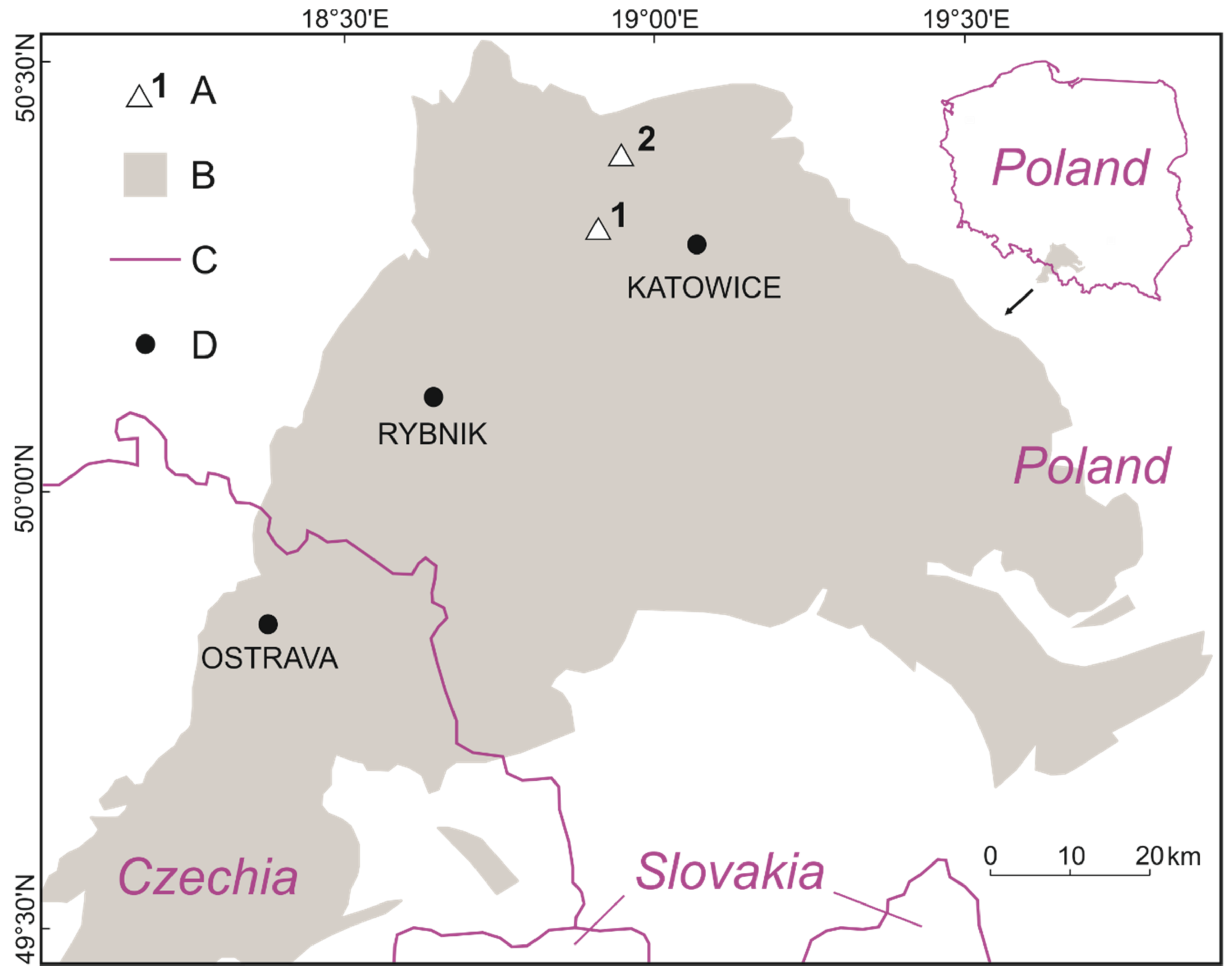
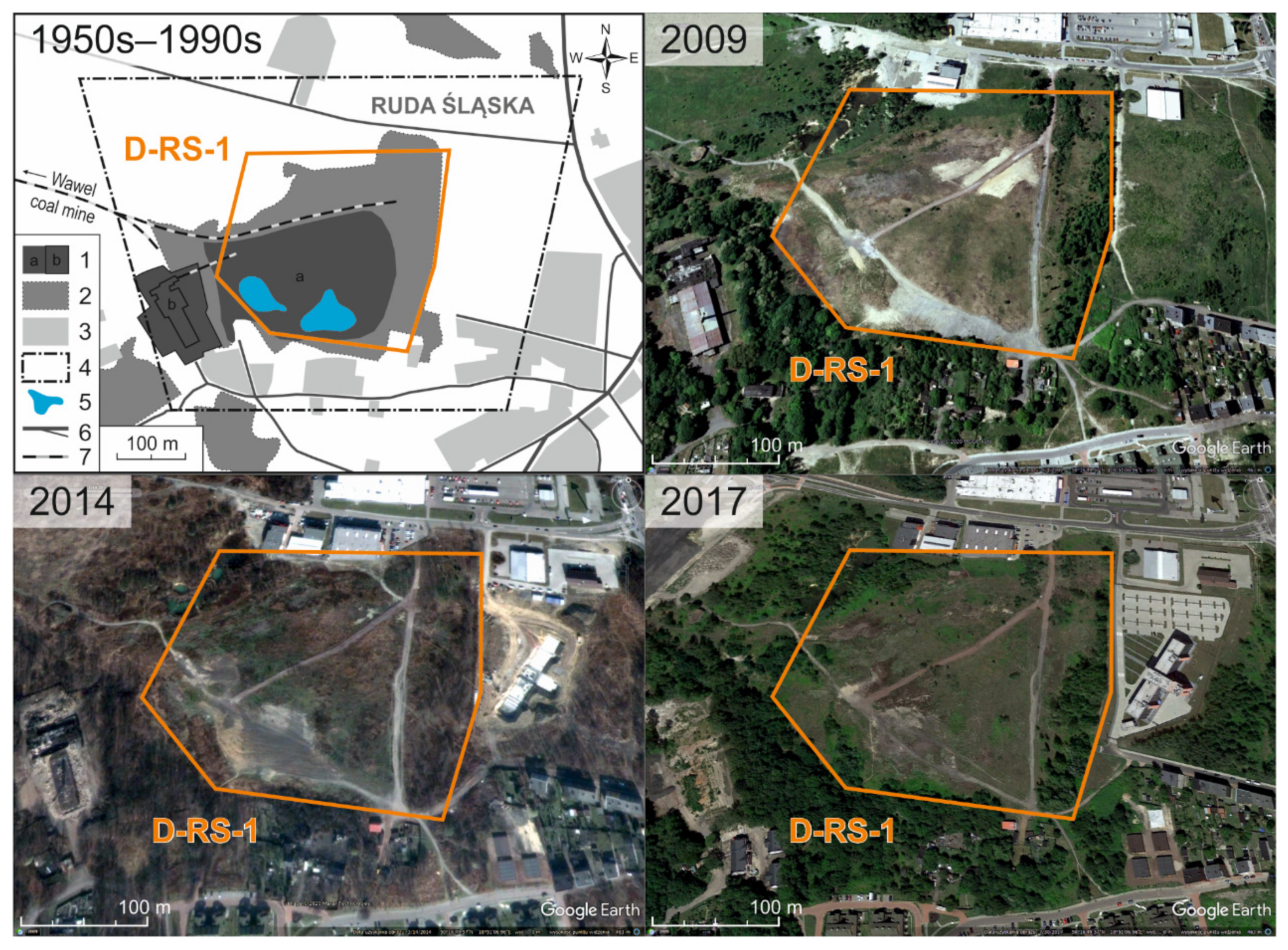
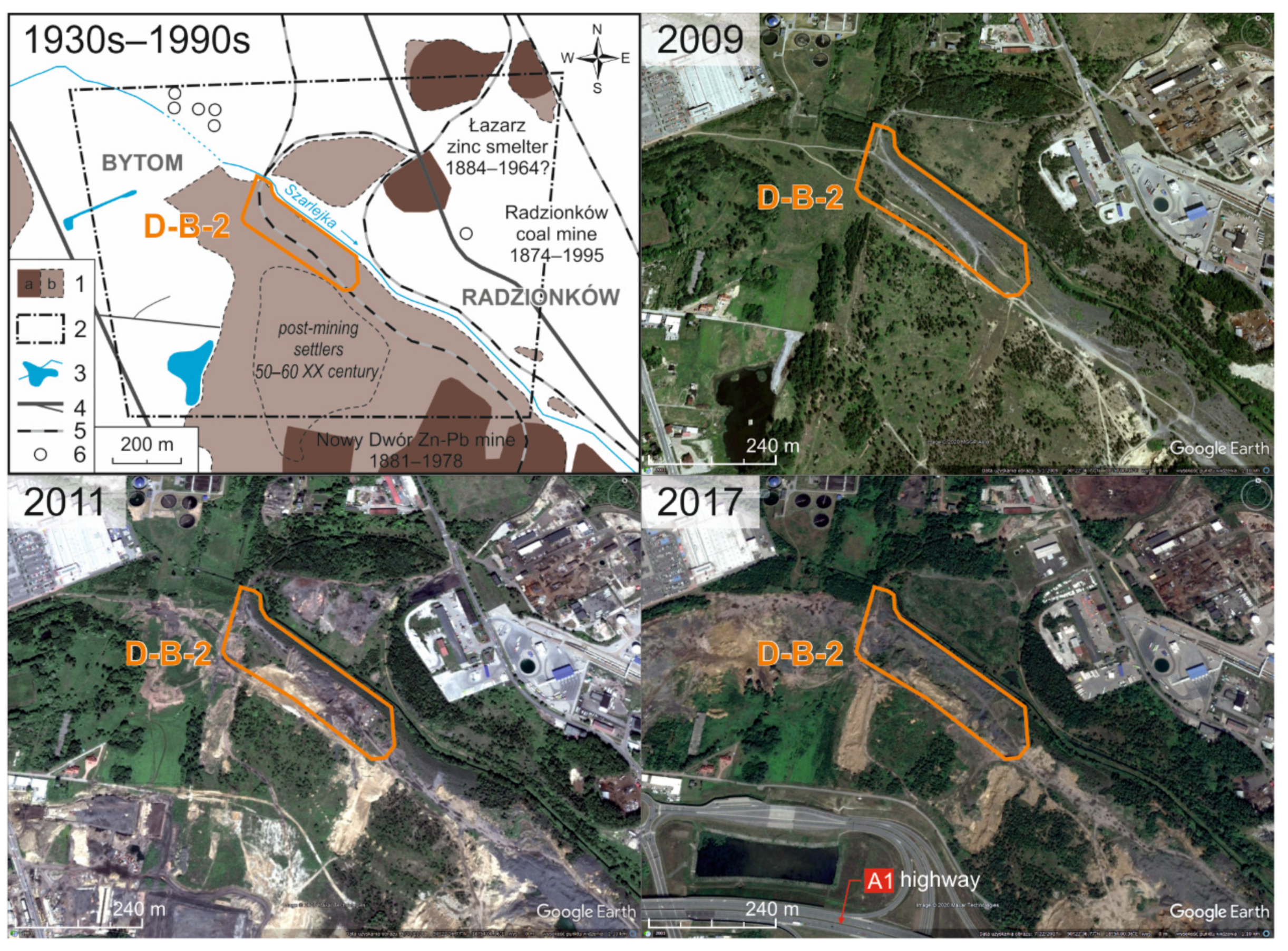
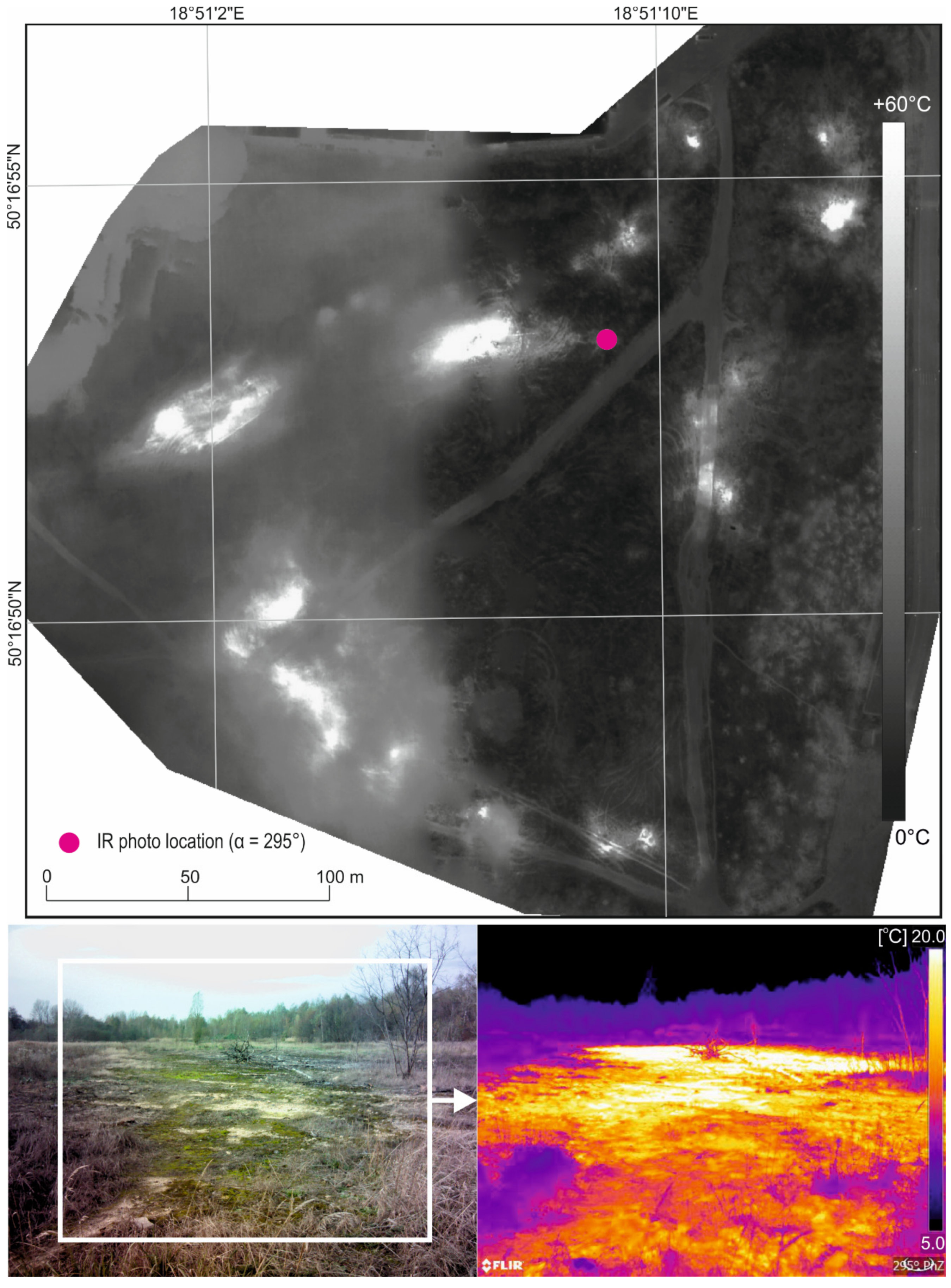
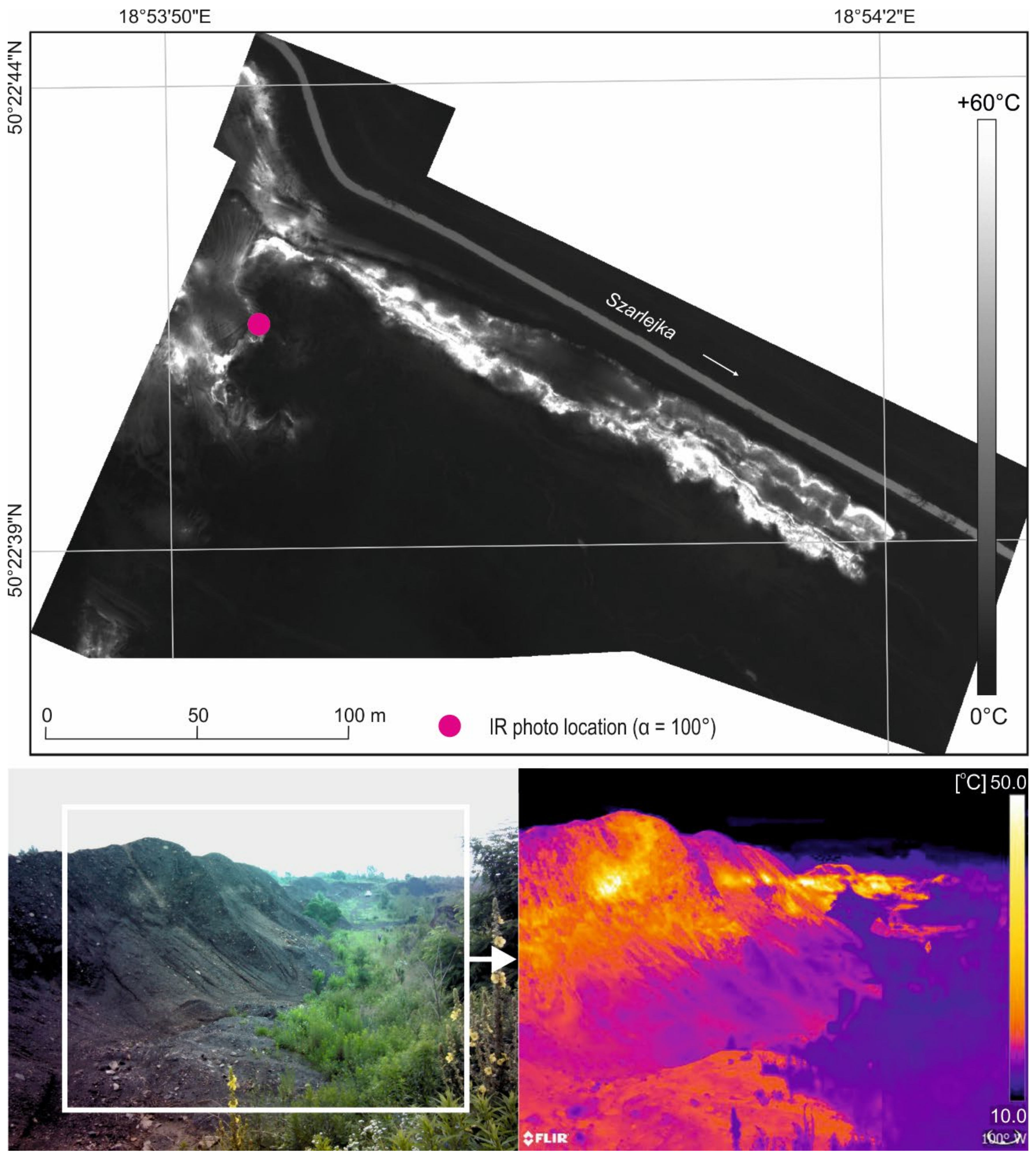

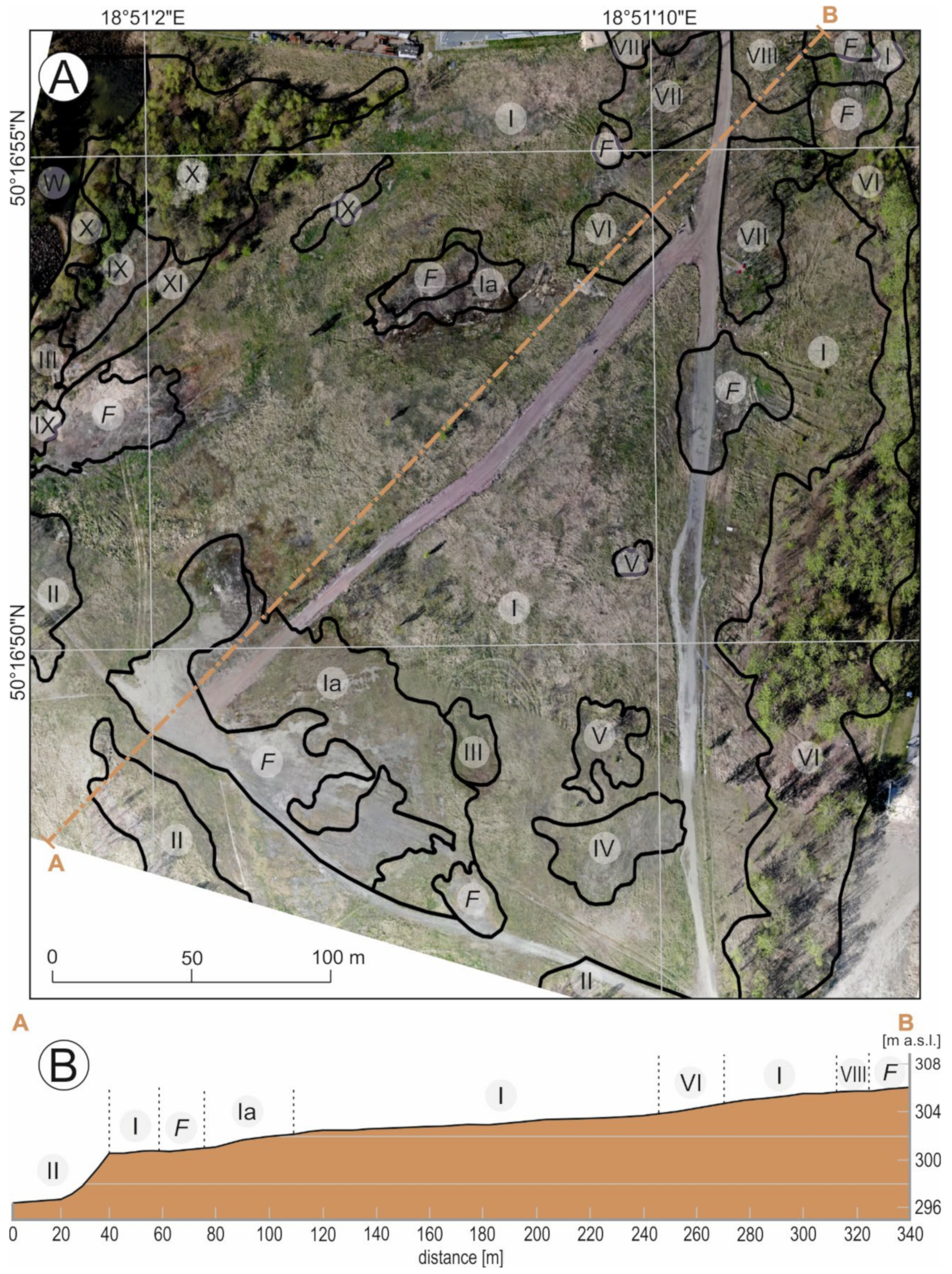
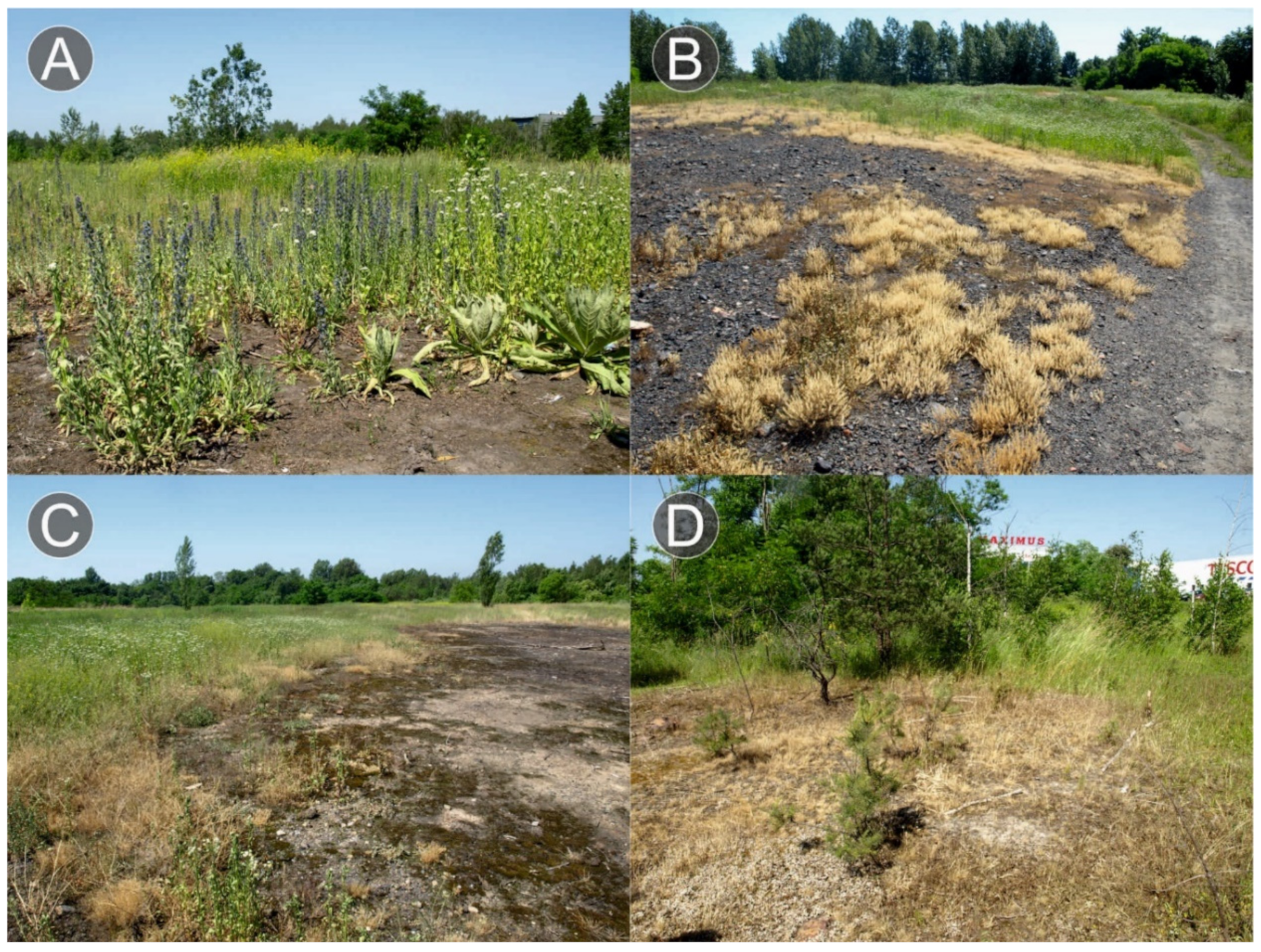

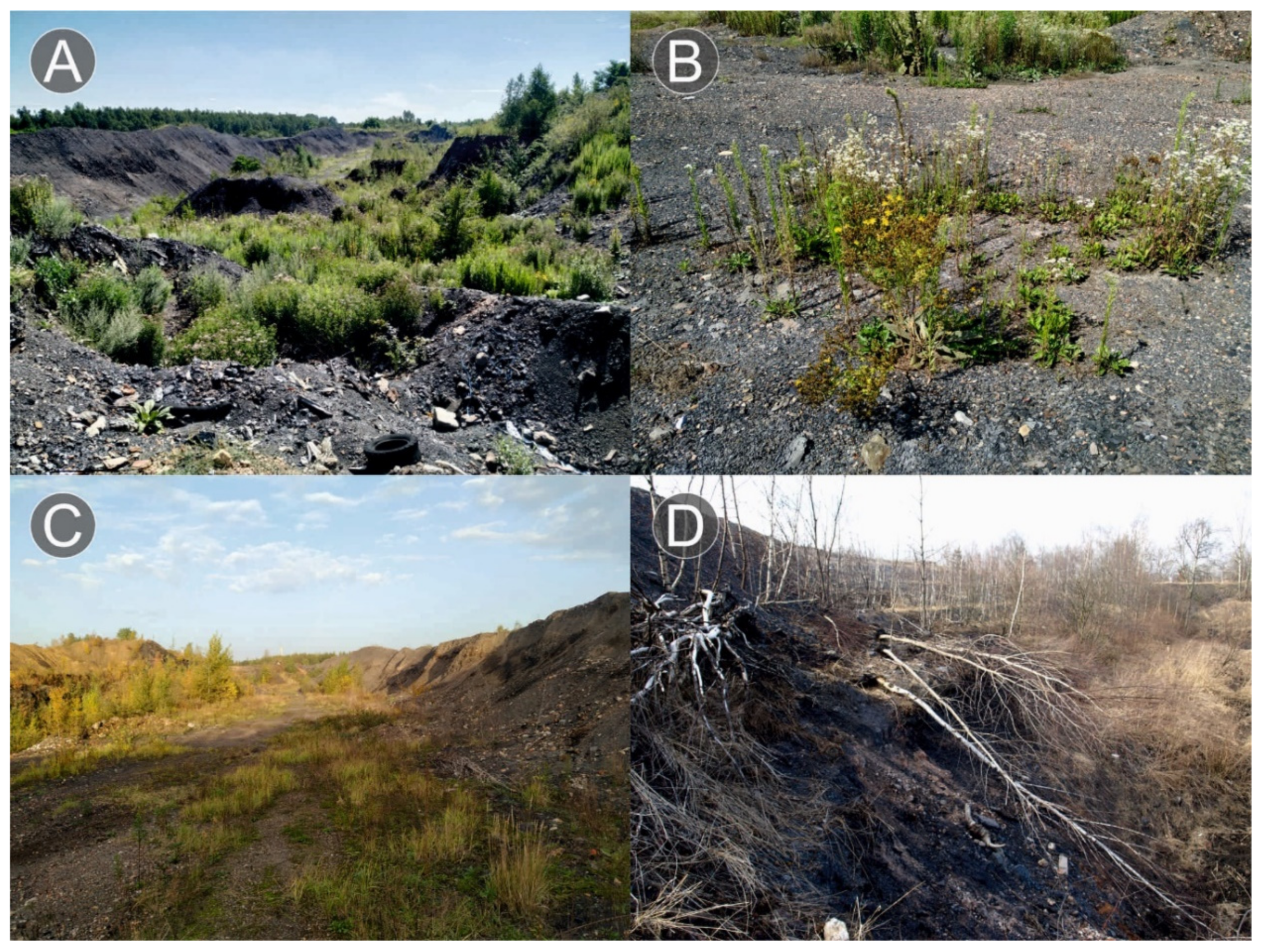
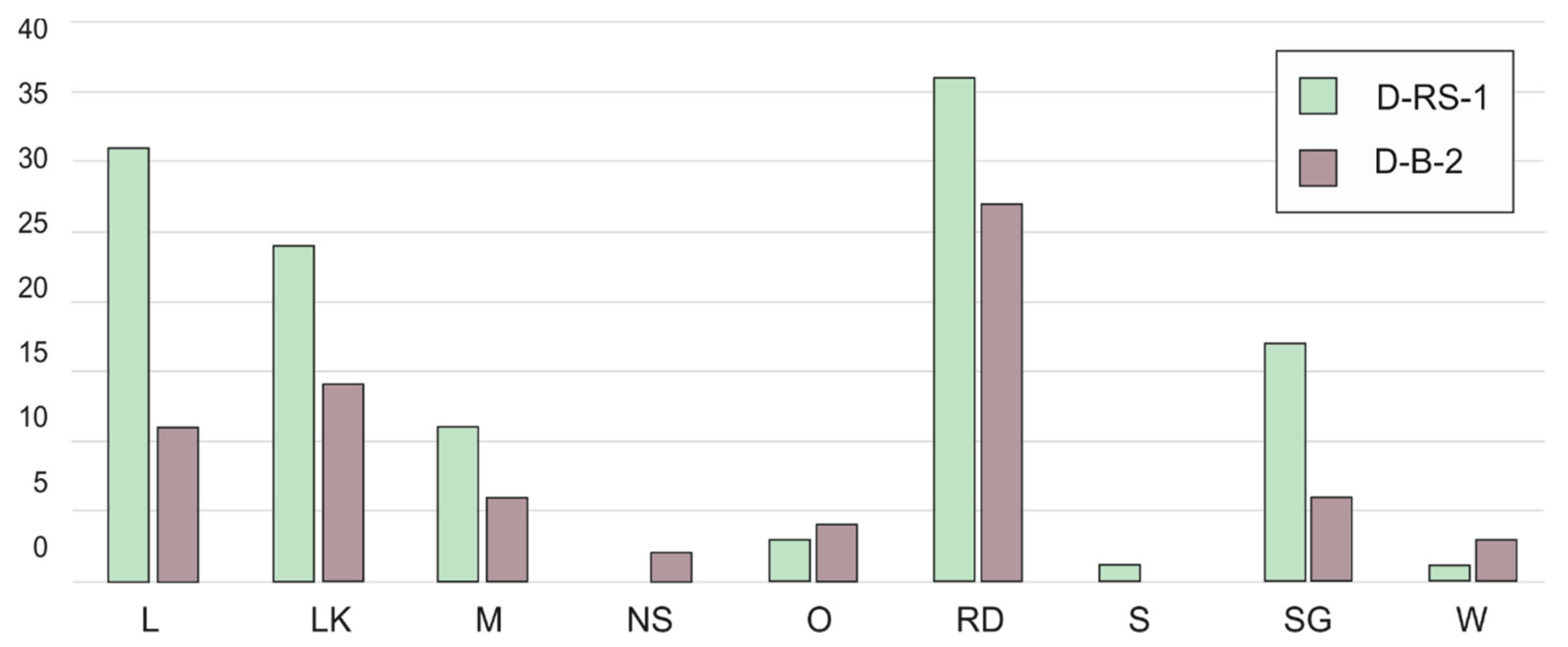
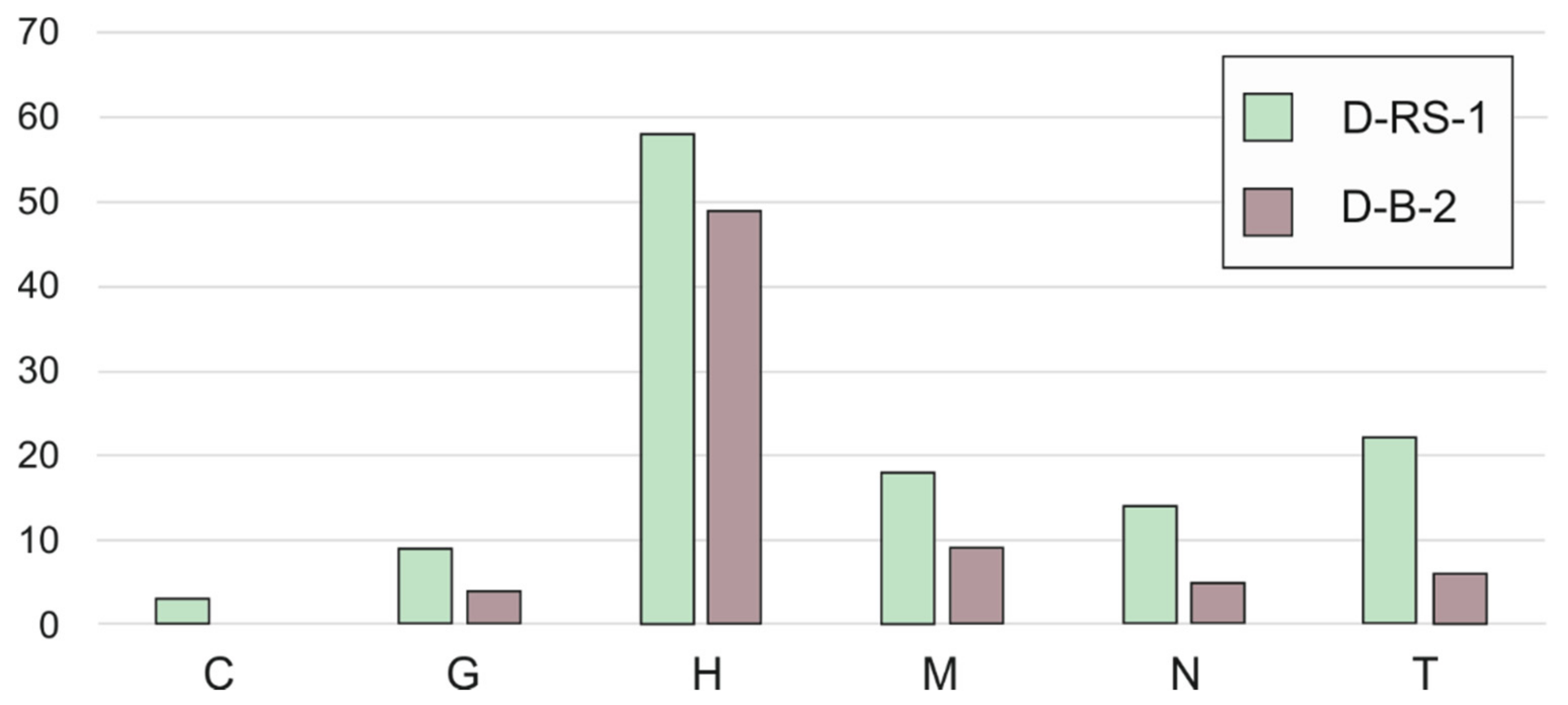
| D-RS-1 | D-B-2 | |
|---|---|---|
| Location | Ruda Śląska (within settlements) | Bytom (abandoned land) |
| Year of construction | 1992 | 2010 |
| Type of waste | coal waste | coal, metallurgical and municipal waste |
| Size | 9.6 ha | whole dump 5.1 ha, coal part about 2.5 ha |
| Shape | flat | complex |
| Former land use | brickyard Bielszowice | postmining settlers |
| Management | partially reclaimed | uncontrolled |
| Dumping technology | filling the voids left by the brickyard excavation with rail transport; stored material divided by insulation layers | truck, gravity dumping |
| Reclamation | soil layer and plant introduction | no reclamation |
| Intended land use | partly recreational, partly postindustrial | postindustrial |
| Real land use | recreational, transit zone | postindustrial, recreational |
| Thermal situation | active | active |
| Colonization | dense | loose |
| Families | D-RS-1 | D-B-2 | ||
|---|---|---|---|---|
| Number of Species | (%) | Number of Species | (%) | |
| Asteraceae | 21 | 16.90 | 15 | 20.50 |
| Brassicaceae | 15 | 12.09 | 12 | 16.40 |
| Leguminosae | 7 | 5.64 | 3 | 4.10 |
| Poaceae | 14 | 11.29 | 3 | 4.10 |
| Rosaceae | 12 | 9.67 | 5 | 6.84 |
| Salicaceae | 7 | 5.64 | 3 | 4.10 |
| Share from the total flora | 61.16 | 56.04 | ||
| Land Cover | D-RS-1 | D-B-2 | ||
|---|---|---|---|---|
| (M2) | (%) | (M2) | (%) | |
| Forest and tree stand | 11,736.92 | 12.17 | 5711.83 | 11.23 |
| Meadow and grassland | 73,077.62 | 75.75 | 33,297.48 | 65.49 |
| No cover | 4799.76 | 4.97 | 9681.30 | 19.04 |
| Roads | 4695.04 | 4.87 | 2155.85 | 4.24 |
| Others | 2157.36 | 2.24 | - | - |
| Summary | 96,465.78 | 100.00 | 50,846.46 | 100.00 |
| Class | D-RS-1 | D-B-2 |
|---|---|---|
| Querco-Fagetea, Alneta glutinosae | 2 | 1 |
| Artemisietea | 11 | 6 |
| Chenopodietea | 1 | 0 |
| Epilobietea angustifolii | 1 | 2 |
| Festuco-Brometea, Sedo-Scleranthetea | 6 | 2 |
| Molinio-Arrhenatheretea | 11 | 6 |
| Nardo-Callunetea, Sedo-Scleranthetea | 1 | 2 |
| Phragmitetea, Alneta glutinosae | 1 | 1 |
| Querco-Fagetea | 8 | 3 |
| Rhamno-Prunetea | 7 | 2 |
| Salicetea purpureae | 9 | 2 |
| Sedo-Scleranthetea | 1 | 0 |
| Stellarietea mediae | 10 | 4 |
| Trifolio-Geranietea | 1 | 1 |
| Vaccino-Piceetea, Querco-Fagetea | 3 | 2 |
| Order | D-RS-1 | D-B-2 |
| Arrhenatheretalia elatioris | 7 | 5 |
| Atropetalia, Onopordetalia | 1 | 2 |
| Caricetalia nigrae | 1 | 1 |
| Centauretalia cyanii | 1 | 2 |
| Convolvuletalia sepium | 6 | 2 |
| Corynephoretalia, Arrhenatheretalia | 7 | 5 |
| Eragrostetalia | 2 | 2 |
| Fagetalia sylvaticae | 5 | 4 |
| Glechometalia hederaceae | 0 | 1 |
| Molinietalia caeruleae | 2 | 2 |
| Nardetetalia | 1 | 0 |
| Onopordetalia acanthii | 1 | 3 |
| Polygono-Chenopodietalia | 2 | 2 |
| Quercetalia pubescentis | 4 | 2 |
| Sisymbrietalia | 2 | 2 |
| Trifolio fragiferae-Agrostietalia stoloniferae | 0 | 2 |
Publisher’s Note: MDPI stays neutral with regard to jurisdictional claims in published maps and institutional affiliations. |
© 2020 by the authors. Licensee MDPI, Basel, Switzerland. This article is an open access article distributed under the terms and conditions of the Creative Commons Attribution (CC BY) license (http://creativecommons.org/licenses/by/4.0/).
Share and Cite
Abramowicz, A.; Rahmonov, O.; Chybiorz, R. Environmental Management and Landscape Transformation on Self-Heating Coal-Waste Dumps in the Upper Silesian Coal Basin. Land 2021, 10, 23. https://doi.org/10.3390/land10010023
Abramowicz A, Rahmonov O, Chybiorz R. Environmental Management and Landscape Transformation on Self-Heating Coal-Waste Dumps in the Upper Silesian Coal Basin. Land. 2021; 10(1):23. https://doi.org/10.3390/land10010023
Chicago/Turabian StyleAbramowicz, Anna, Oimahmad Rahmonov, and Ryszard Chybiorz. 2021. "Environmental Management and Landscape Transformation on Self-Heating Coal-Waste Dumps in the Upper Silesian Coal Basin" Land 10, no. 1: 23. https://doi.org/10.3390/land10010023
APA StyleAbramowicz, A., Rahmonov, O., & Chybiorz, R. (2021). Environmental Management and Landscape Transformation on Self-Heating Coal-Waste Dumps in the Upper Silesian Coal Basin. Land, 10(1), 23. https://doi.org/10.3390/land10010023





